Linked comprehension type questions passage from G.R. BATHLA & SONS CHEMISTRY Chapter 11 HALOALKANES AND HALOARENES for Class 12
| Class 12 | CHEMISTRY |
| Chapter | HALOALKANES AND HALOARENES |
| G.R. BATHLA & SONS CHEMISTRY | Linked comprehension type questions passage |
| Medium | English |
| Academic Year | 2023-2024 |
Question 1
The high reactivity of alkyl halides can be explained in tems of nature of C-X bond which is highly polarised covalent bond due to large difference in the electronegativities of carbon and halogen atom. This polarity is responsible for the nucleophilic substitution reaction of alkyl halides which mostly occur by SN1 and SN2 mechanisms. SN1 reaction is a two step process and in the first step R-X ionises to give carbocation (slow process). In the second step the nucleophilic attacks the carbocation from either side to form the prodcut (fast process) . In SN1 reaction there can be reacemization and inversion . SN1 reaction is favoured by heavy (bulky) groups on the carbon atom attached to halogens.
i.e., R3C−X>R2CH−X>RCH2X>CH3X. In SN2 reaction the strong nucleophilie OH− attacks from the opposite side of the chlorine atom to give an inyermediate (transition state).
which breaks to yield the product (alcohol) and leaving (X−) group. The alcohol has a configuration opposite to that of the bromide and is said to proceed with inversion of configuration. SN2 reaction is favoured by small groups on the carbon atom attached to halogen i.e., CH3−X>R−CH2X>R2CHX>R3C−X
Which among the following will not give SN1 reaction?View SolutionQuestion 2
The high reactivity of alkyl halides can be explained in tems of nature of C-X bond which is highly polarised covalent bond due to large difference in the electronegativities of carbon and halogen atom. This polarity is responsible for the nucleophilic substitution reaction of alkyl halides which mostly occur by SN1 and SN2 mechanisms. SN1 reaction is a two step process and in the first step R-X ionises to give carbocation (slow process). In the second step the nucleophilic attacks the carbocation from either side to form the prodcut (fast process) . In SN1 reaction there can be reacemization and inversion . SN1 reaction is favoured by heavy (bulky) groups on the carbon atom attached to halogens.
i.e., R3C−X>R2CH−X>RCH2X>CH3X. In SN2 reaction the strong nucleophilie OH− attacks from the opposite side of the chlorine atom to give an inyermediate (transition state).
which breaks to yield the product (alcohol) and leaving (X−) group. The alcohol has a configuration opposite to that of the bromide and is said to proceed with inversion of configuration. SN2 reaction is favoured by small groups on the carbon atom attached to halogen i.e., CH3−X>R−CH2X>R2CHX>R3C−X
SN1 reaction of optically active alkyl halide leads to : View SolutionQuestion 3
The high reactivity of alkyl halides can be explained in tems of nature of C-X bond which is highly polarised covalent bond due to large difference in the electronegativities of carbon and halogen atom. This polarity is responsible for the nucleophilic substitution reaction of alkyl halides which mostly occur by SN1 and SN2 mechanisms. SN1 reaction is a two step process and in the first step R-X ionises to give carbocation (slow process). In the second step the nucleophilic attacks the carbocation from either side to form the prodcut (fast process) . In SN1 reaction there can be reacemization and inversion . SN1 reaction is favoured by heavy (bulky) groups on the carbon atom attached to halogens.
i.e., R3C−X>R2CH−X>RCH2X>CH3X. In SN2 reaction the strong nucleophilie OH− attacks from the opposite side of the chlorine atom to give an inyermediate (transition state).
which breaks to yield the product (alcohol) and leaving (X−) group. The alcohol has a configuration opposite to that of the bromide and is said to proceed with inversion of configuration. SN2 reaction is favoured by small groups on the carbon atom attached to halogen i.e., CH3−X>R−CH2X>R2CHX>R3C−X
An SN2 reaction at an asymmetric carbon of a compound always gives: View SolutionQuestion 4
The high reactivity of alkyl halides can be explained in tems of nature of C-X bond which is highly polarised covalent bond due to large difference in the electronegativities of carbon and halogen atom. This polarity is responsible for the nucleophilic substitution reaction of alkyl halides which mostly occur by SN1 and SN2 mechanisms. SN1 reaction is a two step process and in the first step R-X ionises to give carbocation (slow process). In the second step the nucleophilic attacks the carbocation from either side to form the prodcut (fast process) . In SN1 reaction there can be reacemization and inversion . SN1 reaction is favoured by heavy (bulky) groups on the carbon atom attached to halogens.
i.e., R3C−X>R2CH−X>RCH2X>CH3X. In SN2 reaction the strong nucleophilie OH− attacks from the opposite side of the chlorine atom to give an inyermediate (transition state).
which breaks to yield the product (alcohol) and leaving (X−) group. The alcohol has a configuration opposite to that of the bromide and is said to proceed with inversion of configuration. SN2 reaction is favoured by small groups on the carbon atom attached to halogen i.e., CH3−X>R−CH2X>R2CHX>R3C−X
The main product formed in the following reaction is
CH3−CH∣CH3−CH2Br+CH3CH2O−SN1−−→View SolutionQuestion 5
The high reactivity of alkyl halides can be explained in tems of nature of C-X bond which is highly polarised covalent bond due to large difference in the electronegativities of carbon and halogen atom. This polarity is responsible for the nucleophilic substitution reaction of alkyl halides which mostly occur by SN1 and SN2 mechanisms. SN1 reaction is a two step process and in the first step R-X ionises to give carbocation (slow process). In the second step the nucleophilic attacks the carbocation from either side to form the prodcut (fast process) . In SN1 reaction there can be reacemization and inversion . SN1 reaction is favoured by heavy (bulky) groups on the carbon atom attached to halogens.
i.e., R3C−X>R2CH−X>RCH2X>CH3X. In SN2 reaction the strong nucleophilie OH− attacks from the opposite side of the chlorine atom to give an inyermediate (transition state).
which breaks to yield the product (alcohol) and leaving (X−) group. The alcohol has a configuration opposite to that of the bromide and is said to proceed with inversion of configuration. SN2 reaction is favoured by small groups on the carbon atom attached to halogen i.e., CH3−X>R−CH2X>R2CHX>R3C−X
Which of the following is an example of SN2 reaction ? View SolutionQuestion 6
Karl Ziegler reported that alkenes react with N-bromosuccinimide (NBS) in presence of light to give products resulting from substitution of hydrogen by bromine at the allylic position i.e., the position next to the double bond.
Let us consider the halogenation of cyclohexane.

Energy level diagram for allylic vinylic and alkylic free redicals is given below:
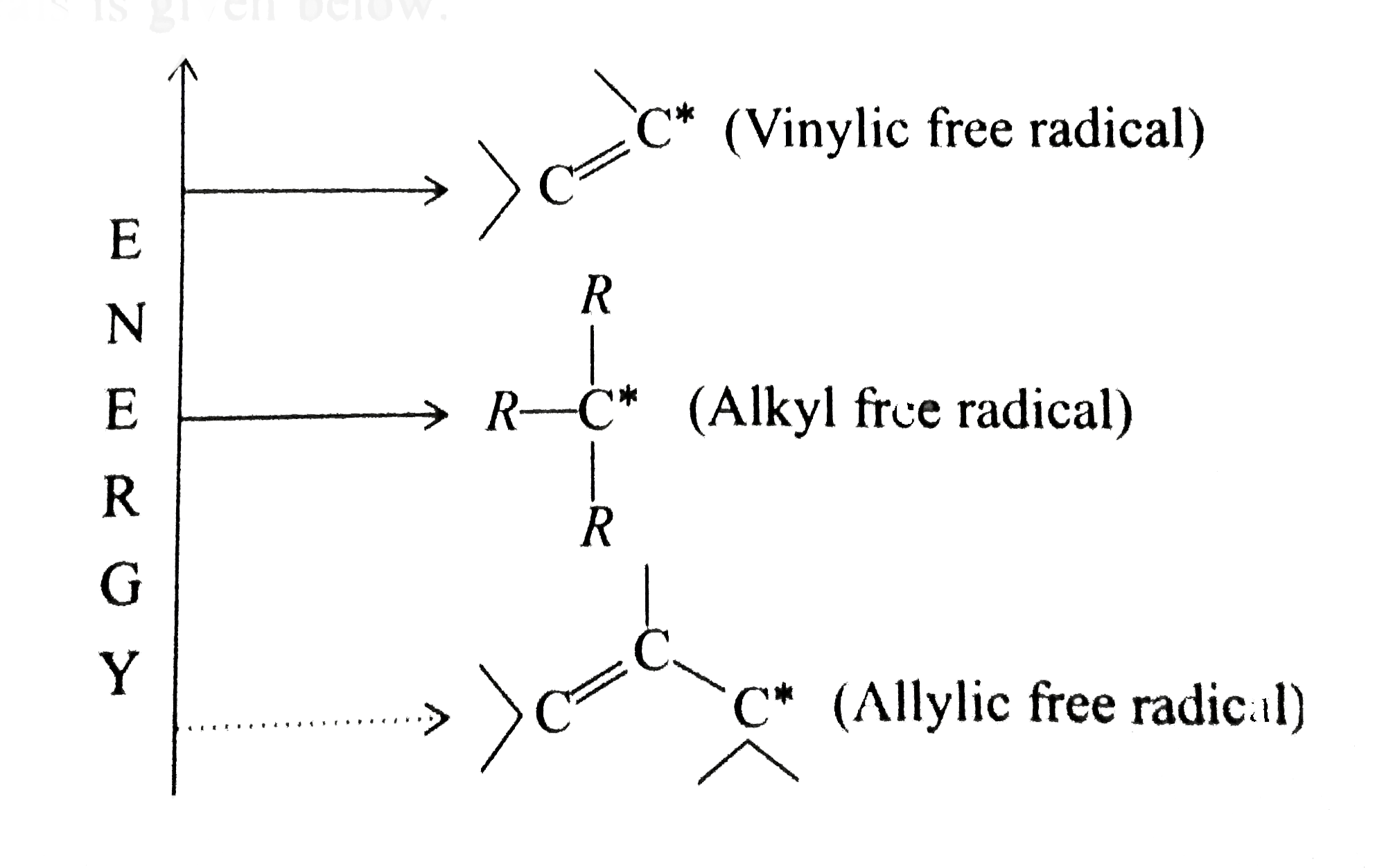
Select the correct statement(s) among the following : View SolutionQuestion 7
Karl Ziegler reported that alkenes react with N-bromosuccinimide (NBS) in presence of light to give products resulting from substitution of hydrogen by bromine at the allylic position i.e., the position next to the double bond.
Let us consider the halogenation of cyclohexane.

Energy level diagram for allylic vinylic and alkylic free redicals is given below:
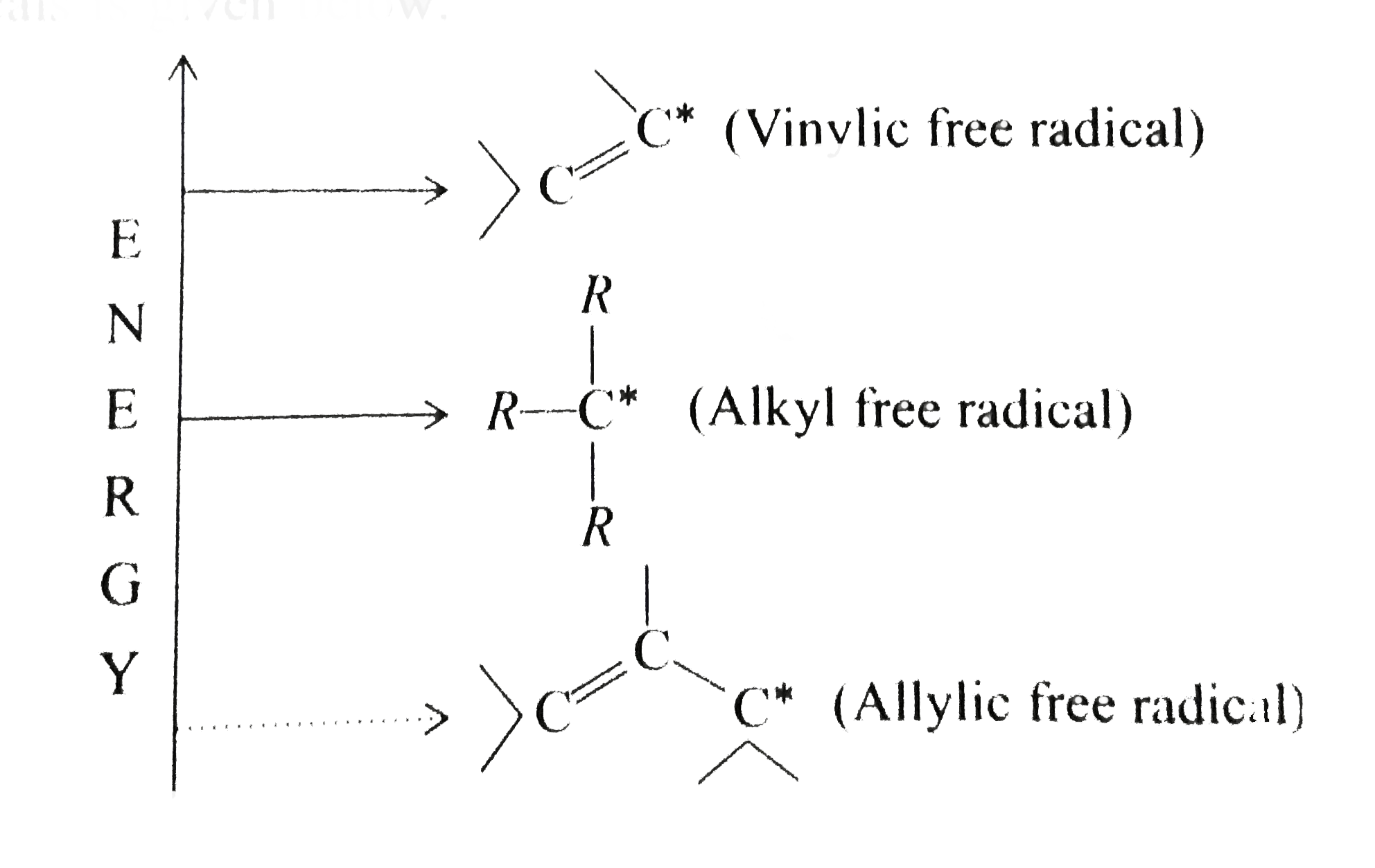
Consider the three types of C-H bonds in cyclohexene.
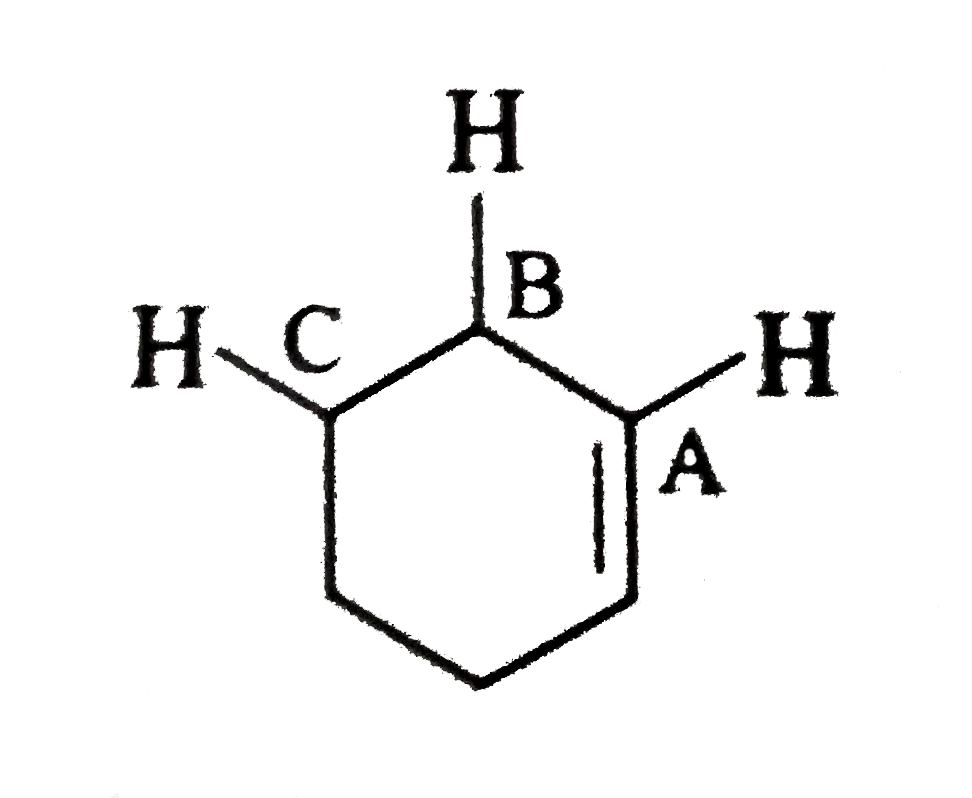
Which of the following is/arecorrectly matched? View SolutionQuestion 8
Karl Ziegler reported that alkenes react with N-bromosuccinimide (NBS) in presence of light to give products resulting from substitution of hydrogen by bromine at the allylic position i.e., the position next to the double bond.
Let us consider the halogenation of cyclohexane.

Energy level diagram for allylic vinylic and alkylic free redicals is given below:

Which of the following sequences is correct about C-H bond energy ? View SolutionQuestion 9
Karl Ziegler reported that alkenes react with N-bromosuccinimide (NBS) in presence of light to give products resulting from substitution of hydrogen by bromine at the allylic position i.e., the position next to the double bond.
Let us consider the halogenation of cyclohexane.

Energy level diagram for allylic vinylic and alkylic free redicals is given below:

Select the correct statement(s) among the following : View SolutionQuestion 10
Karl Ziegler reported that alkenes react with N-bromosuccinimide (NBS) in presence of light to give products resulting from substitution of hydrogen by bromine at the allylic position i.e., the position next to the double bond.
Let us consider the halogenation of cyclohexane.

Energy level diagram for allylic vinylic and alkylic free redicals is given below:
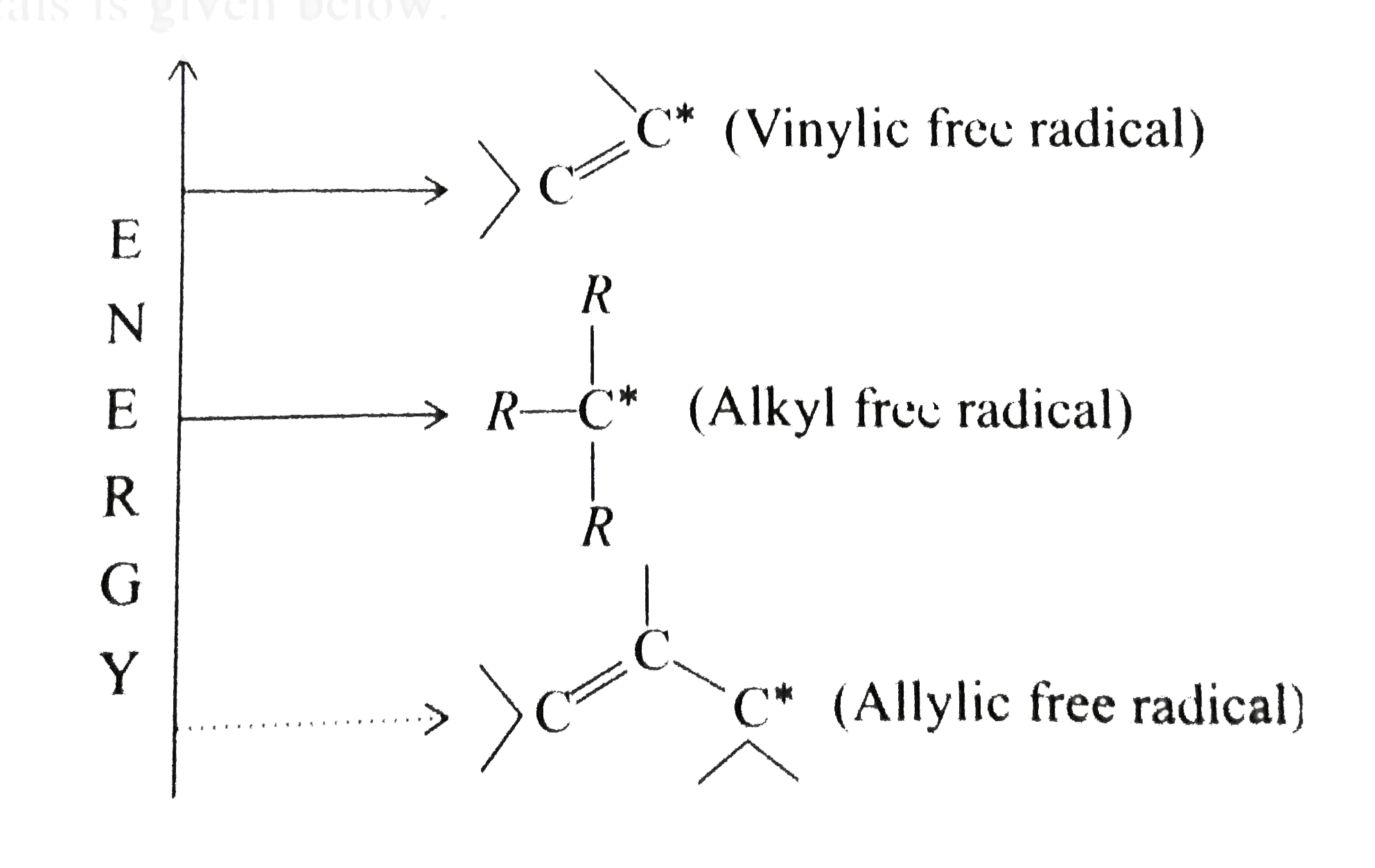
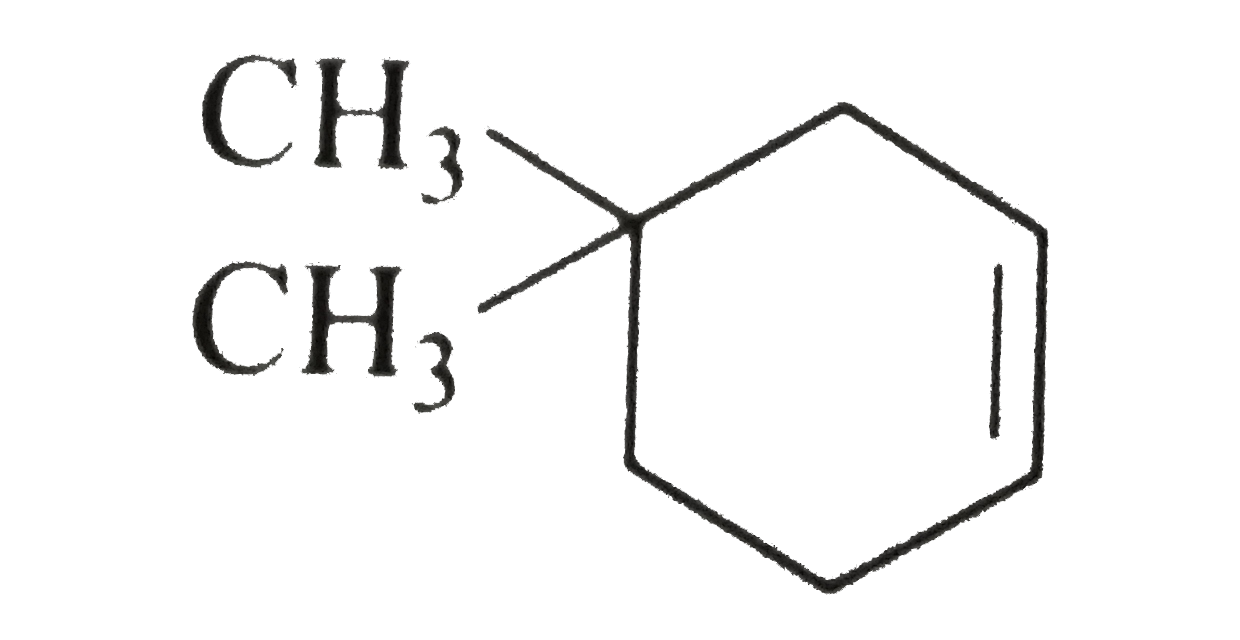
(4,4-Dimethyl cyclohexene)
Above compound on treatment with NBS gives allylic bromides . How many product (s) will be obtained in this reaction?View SolutionQuestion 11
The removal of two atoms or groups one generally hydrogen (H+) and the other a leaving group (L−) resulting in the formation of unsaturated compound is known as elimination reaction.
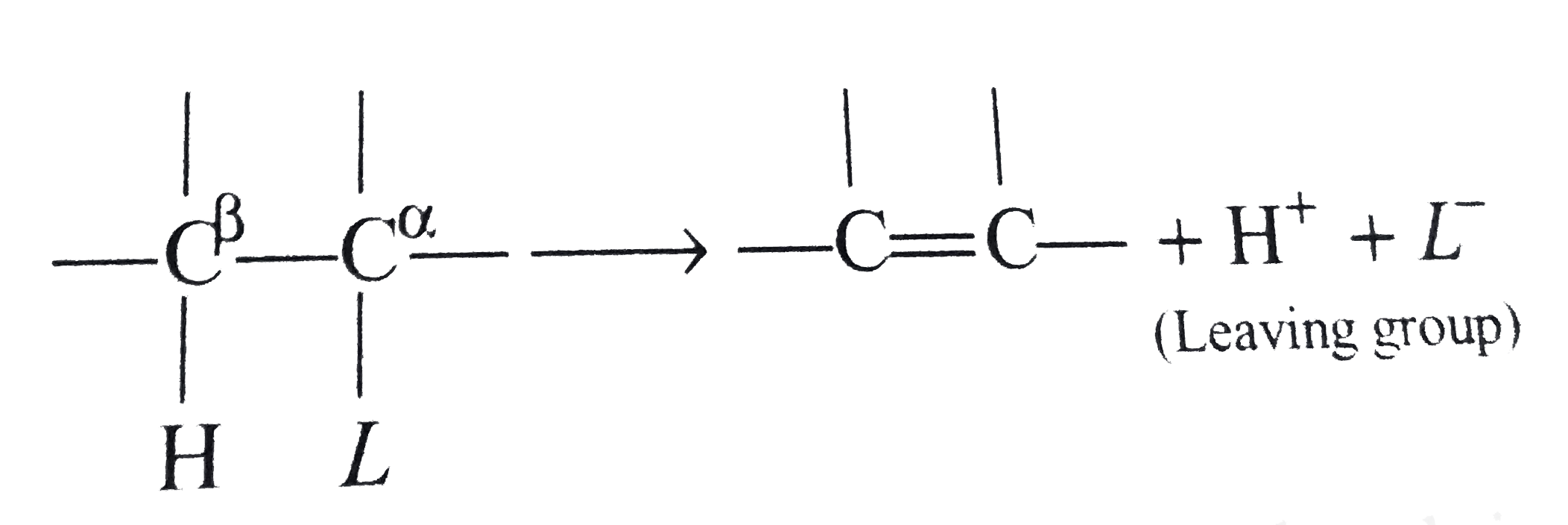
In E1 (elimination) reactions the C-L bond is broken heterolytically (in step 1) to form a carbocation ( as in SN1 reaction) in which (L−) is lost (rate determining step). The carbocation (in step 2) loses a proton from the β− carbon atom by a base (nucleophile) to form an alkene. E1 reaction is favoured in compounds in which the leaving group is at secondar (2∘) or tertiary(3∘) Position.
In E2 (elimination) reactions two sigma bonds are broken and a π−bond is formed simultaneously.E2 reactions occur in one step through a transition state.

E2 reactions are most common in haloalkanes (particulary 1∘) and better the leaving group higher is the E2 reaction. In E2 reactions, both the leaving groups should be antiplaner.
E1cb (Elimination unimolecular conjugate base) reaction involves the removal of proton by a conjugate base (step 1) to produce carbanion which loses a leaving group to form an alkene (step 2) and is a slow step
Isopropyl chloride on heating with concentrated solution of ethanolic KOH gives mainly:View SolutionQuestion 12
The removal of two atoms or groups one generally hydrogen (H+) and the other a leaving group (L−) resulting in the formation of unsaturated compound is known as elimination reaction.

In E1 (elimination) reactions the C-L bond is broken heterolytically (in step 1) to form a carbocation ( as in SN1 reaction) in which (L−) is lost (rate determining step). The carbocation (in step 2) loses a proton from the β− carbon atom by a base (nucleophile) to form an alkene. E1 reaction is favoured in compounds in which the leaving group is at secondar (2∘) or tertiary(3∘) Position.
In E2 (elimination) reactions two sigma bonds are broken and a π−bond is formed simultaneously.E2 reactions occur in one step through a transition state.

E2 reactions are most common in haloalkanes (particulary 1∘) and better the leaving group higher is the E2 reaction. In E2 reactions, both the leaving groups should be antiplaner.
E1cb (Elimination unimolecular conjugate base) reaction involves the removal of proton by a conjugate base (step 1) to produce carbanion which loses a leaving group to form an alkene (step 2) and is a slow step
2-Bromonbutane on heating with concentrated solution of alcoholic KOH gives major product as :View SolutionQuestion 13
The removal of two atoms or groups one generally hydrogen (H+) and the other a leaving group (L−) resulting in the formation of unsaturated compound is known as elimination reaction.

In E1 (elimination) reactions the C-L bond is broken heterolytically (in step 1) to form a carbocation ( as in SN1 reaction) in which (L−) is lost (rate determining step). The carbocation (in step 2) loses a proton from the β− carbon atom by a base (nucleophile) to form an alkene. E1 reaction is favoured in compounds in which the leaving group is at secondar (2∘) or tertiary(3∘) Position.
In E2 (elimination) reactions two sigma bonds are broken and a π−bond is formed simultaneously.E2 reactions occur in one step through a transition state.

E2 reactions are most common in haloalkanes (particulary 1∘) and better the leaving group higher is the E2 reaction. In E2 reactions, both the leaving groups should be antiplaner.
E1cb (Elimination unimolecular conjugate base) reaction involves the removal of proton by a conjugate base (step 1) to produce carbanion which loses a leaving group to form an alkene (step 2) and is a slow step
R2CH−C∣X−R2'+:B−(base)→R2C=CR2
+H−B+X−
this reaction is an example of: View SolutionQuestion 14
The removal of two atoms or groups one generally hydrogen (H+) and the other a leaving group (L−) resulting in the formation of unsaturated compound is known as elimination reaction.

In E1 (elimination) reactions the C-L bond is broken heterolytically (in step 1) to form a carbocation (as inSN1 reaction) in which (L−) is lost (rate determining step). The carbocation (in step 2) loses a proton from the β− carbon atom by a base (nucleophile) to form an alkene. E1 reaction is favoured in compounds in which the leaving group is at secondar (2∘) or tertiary(3∘) Position.
In E2 (elimination) reactions two sigma bonds are broken and a π−bond is formed simultaneously.E2 reactions occur in one step through a transition state.

E2 reactions are most common in haloalkanes (particulary 1∘) and better the leaving group higher is the E2 reaction. In E2 reactions, both the leaving groups should be antiplaner.
E1cb (Elimination unimolecular conjugate base) reaction involves the removal of proton by a conjugate base (step 1) to produce carbanion which loses a leaving group to form an alkene (step 2) and is a slow step
2-Bromopentane is heated with potassium ethoxide in ethanol. The major product obtained is : View SolutionQuestion 15
The removal of two atoms or groups one generally hydrogen (H+) and the other a leaving group (L−) resulting in the formation of unsaturated compound is known as elimination reaction.

In E1 (elimination) reactions the C-L bond is broken heterolytically (in step 1) to form a carbocation (as inSN1 reaction) in which (L−) is lost (rate determining step). The carbocation (in step 2) loses a proton from the β− carbon atom by a base (nucleophile) to form an alkene. E1 reaction is favoured in compounds in which the leaving group is at secondar (2∘) or tertiary(3∘) Position.
In E2 (elimination) reactions two sigma bonds are broken and a π−bond is formed simultaneously.E2 reactions occur in one step through a transition state.

E2 reactions are most common in haloalkanes (particulary 1∘) and better the leaving group higher is the E2 reaction. In E2 reactions, both the leaving groups should be antiplaner.
E1cb (Elimination unimolecular conjugate base) reaction involves the removal of proton by a conjugate base (step 1) to produce carbanion which loses a leaving group to form an alkene (step 2) and is a slow step Neopentyl bromide undergoes dehydrohalogenation to give alkene even though it has no β−hydrogen.This is due to :View SolutionQuestion 16
SN1 reaction is a first order nucleophilic substitution e.g.
CH3−CH3∣C∣CH3−Br+H2O→CH3−CH3∣C∣CH3−OH+HBr
The concentration of nucleophile does not appear in the rate law expression.
Reaction rate k[RX]
In a mulptistep organic reaction , the rate-limiting step is the slowest step . Rate determining step is represented by the following energy level diagram: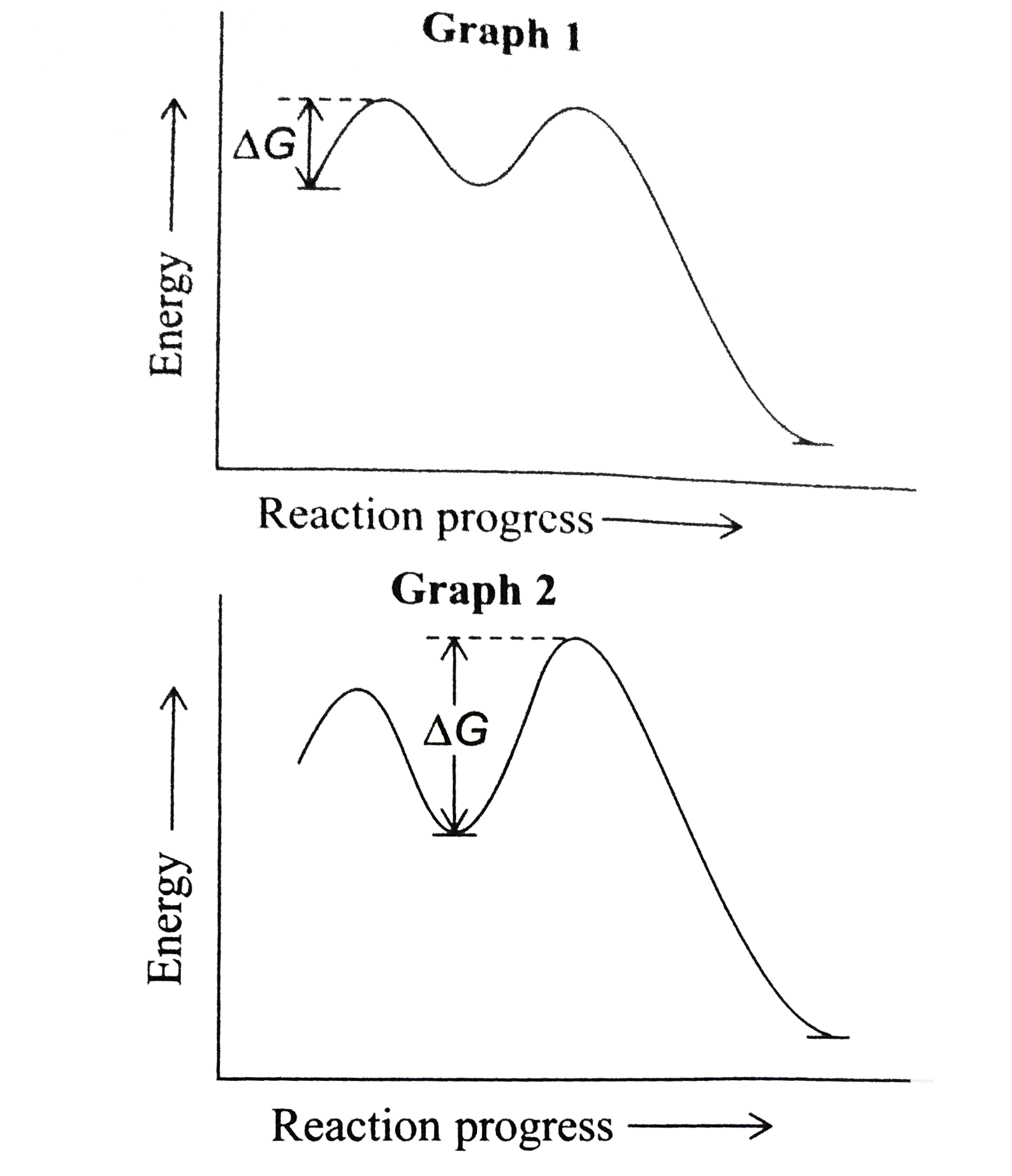
A reaction energy level diagram for an SN1 reaction .The rate limiting step is spontaneous dissociation of an alkyl halide to give a carbocation intermediate:
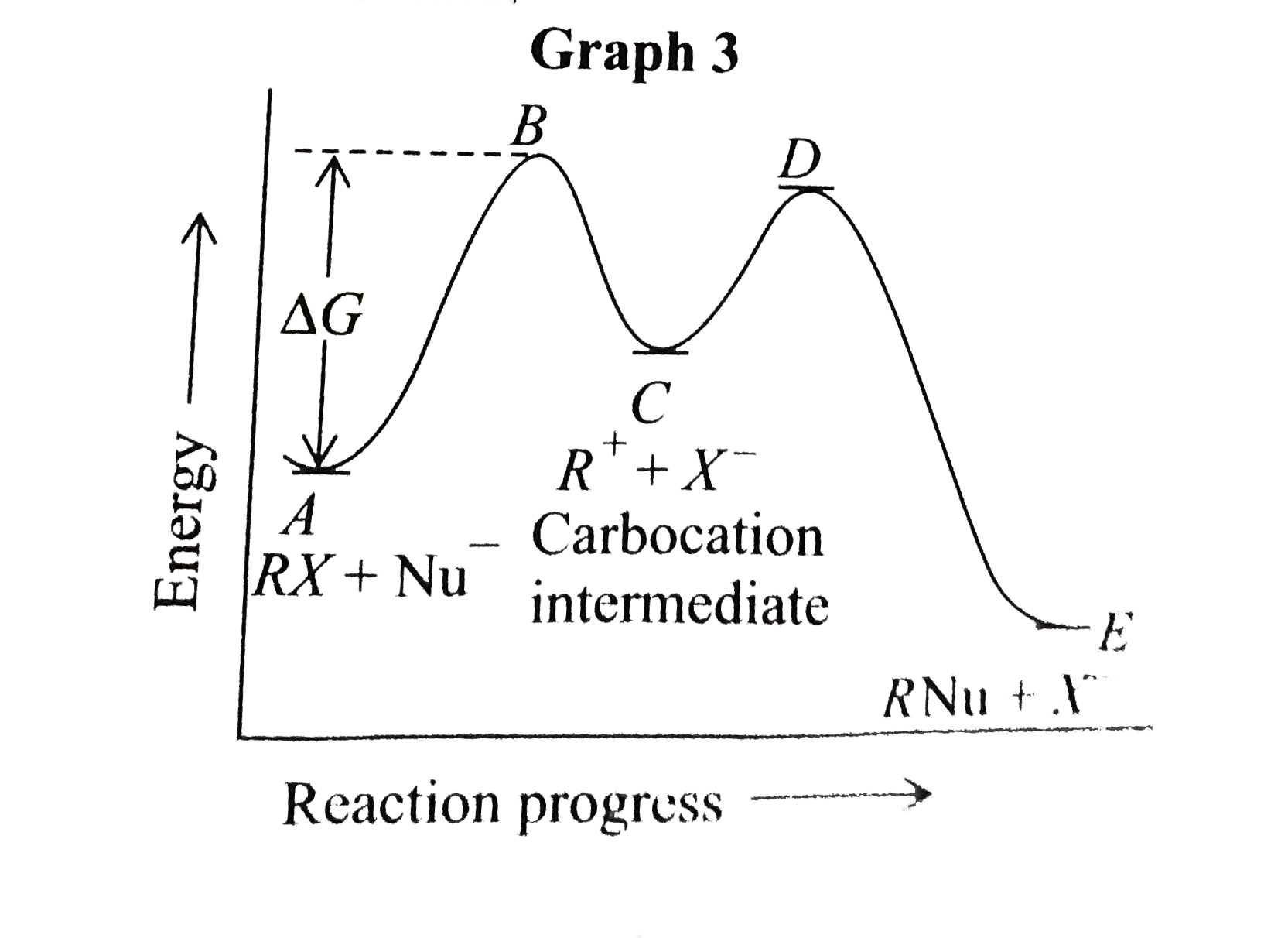
In SN1 reaction the hybridization changes in rate determination step. Select the correct change among the following: View SolutionQuestion 17
SN1 reaction is a first order nucleophilic substitution e.g.
CH3−CH3∣C∣CH3−Br+H2O→CH3−CH3∣C∣CH3−OH+HBr
The concentration of nucleophile does not appear in the rate law expression.
Reaction rate k[RX]
In a mulptistep organic reaction , the rate-limiting step is the slowest step . Rate determining step is represented by the following energy level diagram: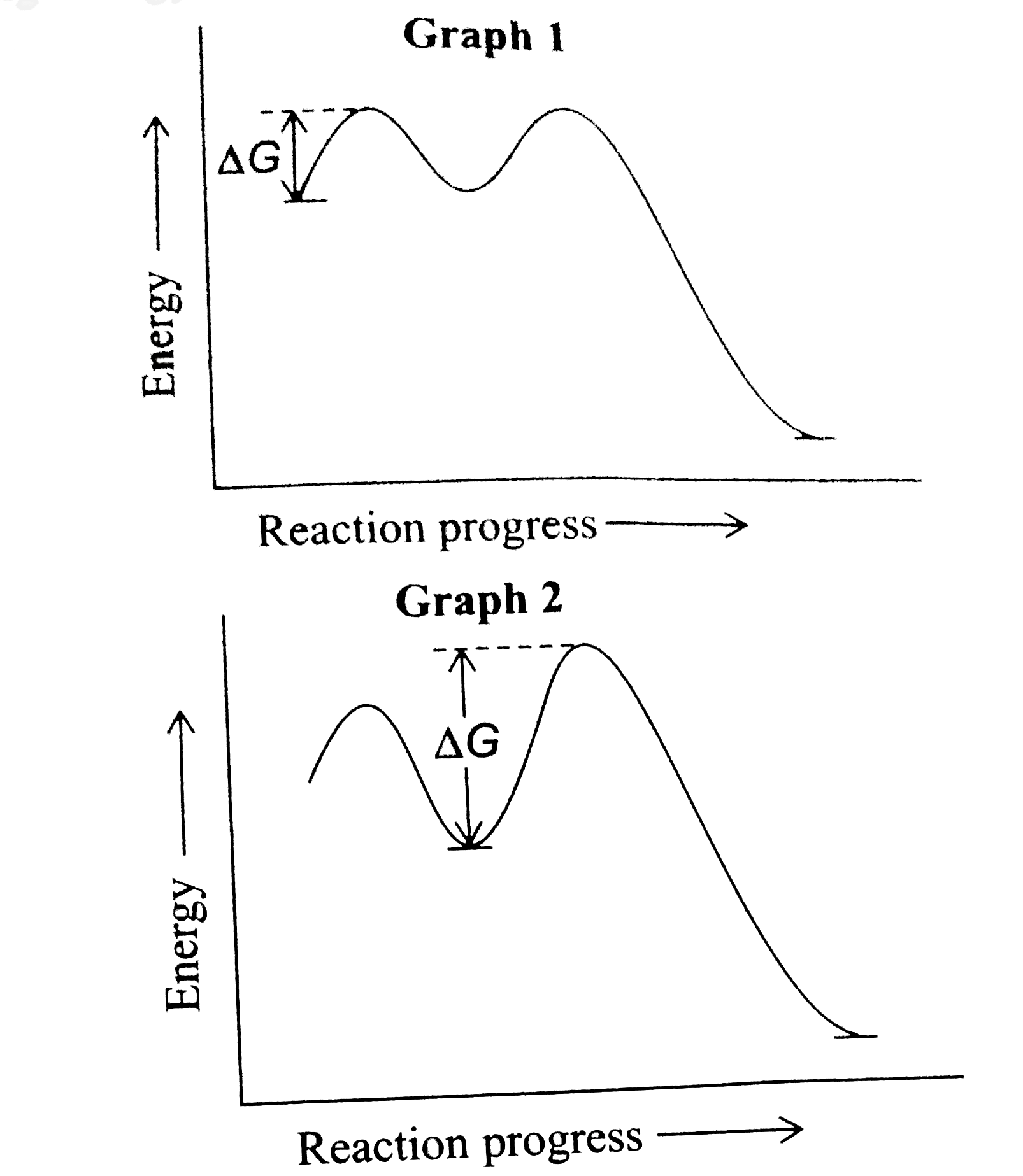
A reaction energy level diagram for an SN1 reaction .The rate limiting step is spontaneous dissociation of an alkyl halide to give a carbocation intermediate:
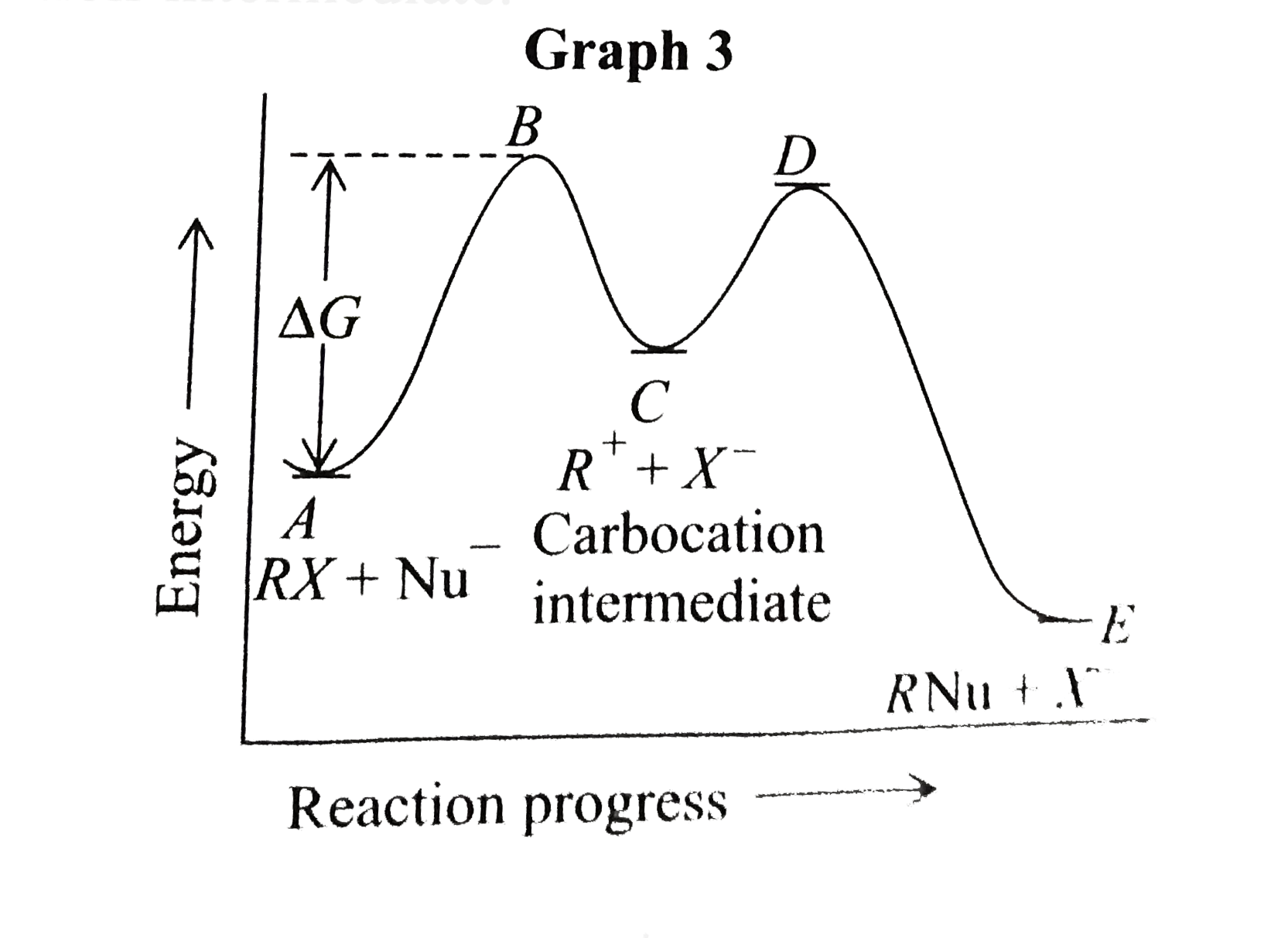
Select the correct statement (s) about the graph 1: View SolutionQuestion 18
SN1 reaction is a first order nucleophilic substitution e.g.
CH3−CH3∣C∣CH3−Br+H2O→CH3−CH3∣C∣CH3−OH+HBr
The concentration of nucleophile does not appear in the rate law expression.
Reaction rate k[RX]
In a mulptistep organic reaction , the rate-limiting step is the slowest step . Rate determining step is represented by the following energy level diagram: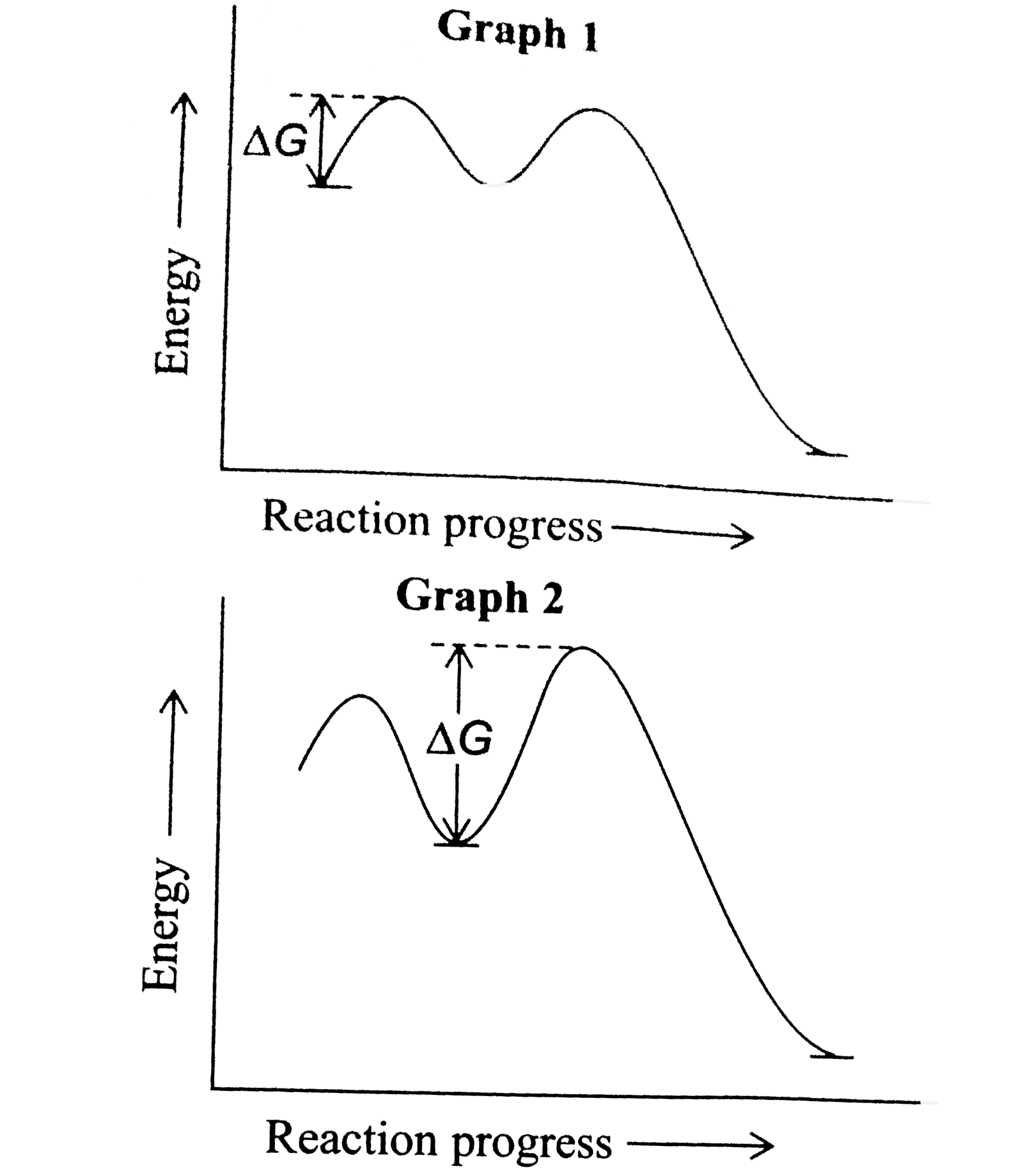
A reaction energy level diagram for an SN1 reaction .The rate limiting step is spontaneous dissociation of an alkyl halide to give a carbocation intermediate:
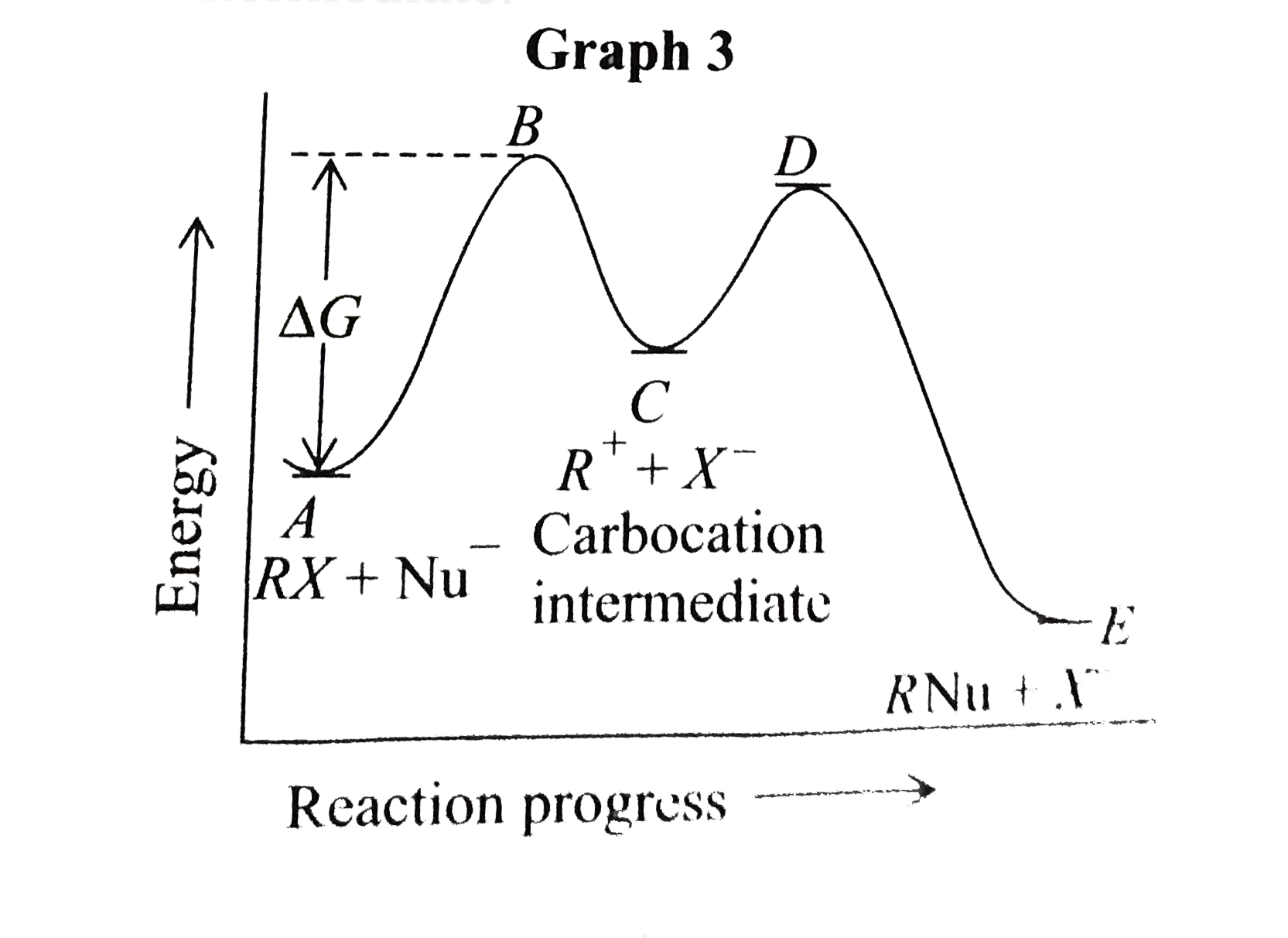
Select the correct statement(s) about the graph 2: View SolutionQuestion 19
SN1 reaction is a first order nucleophilic substitution e.g.
CH3−CH3∣C∣CH3−Br+H2O→CH3−CH3∣C∣CH3−OH+HBr
The concentration of nucleophile does not appear in the rate law expression.
Reaction rate k[RX]
In a mulptistep organic reaction , the rate-limiting step is the slowest step . Rate determining step is represented by the following energy level diagram: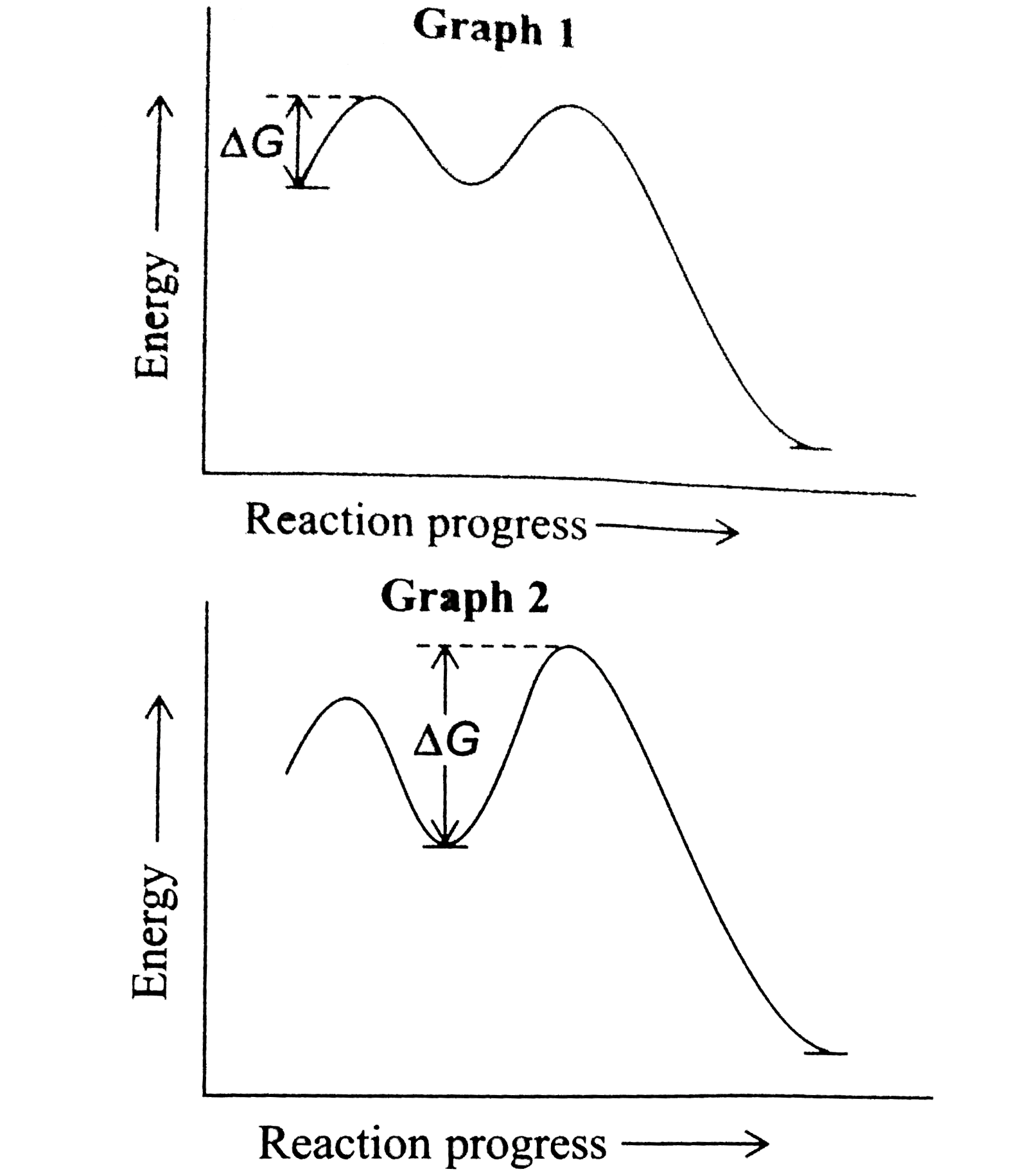
A reaction energy level diagram for an SN1 reaction .The rate limiting step is spontaneous dissociation of an alkyl halide to give a carbocation intermediate:
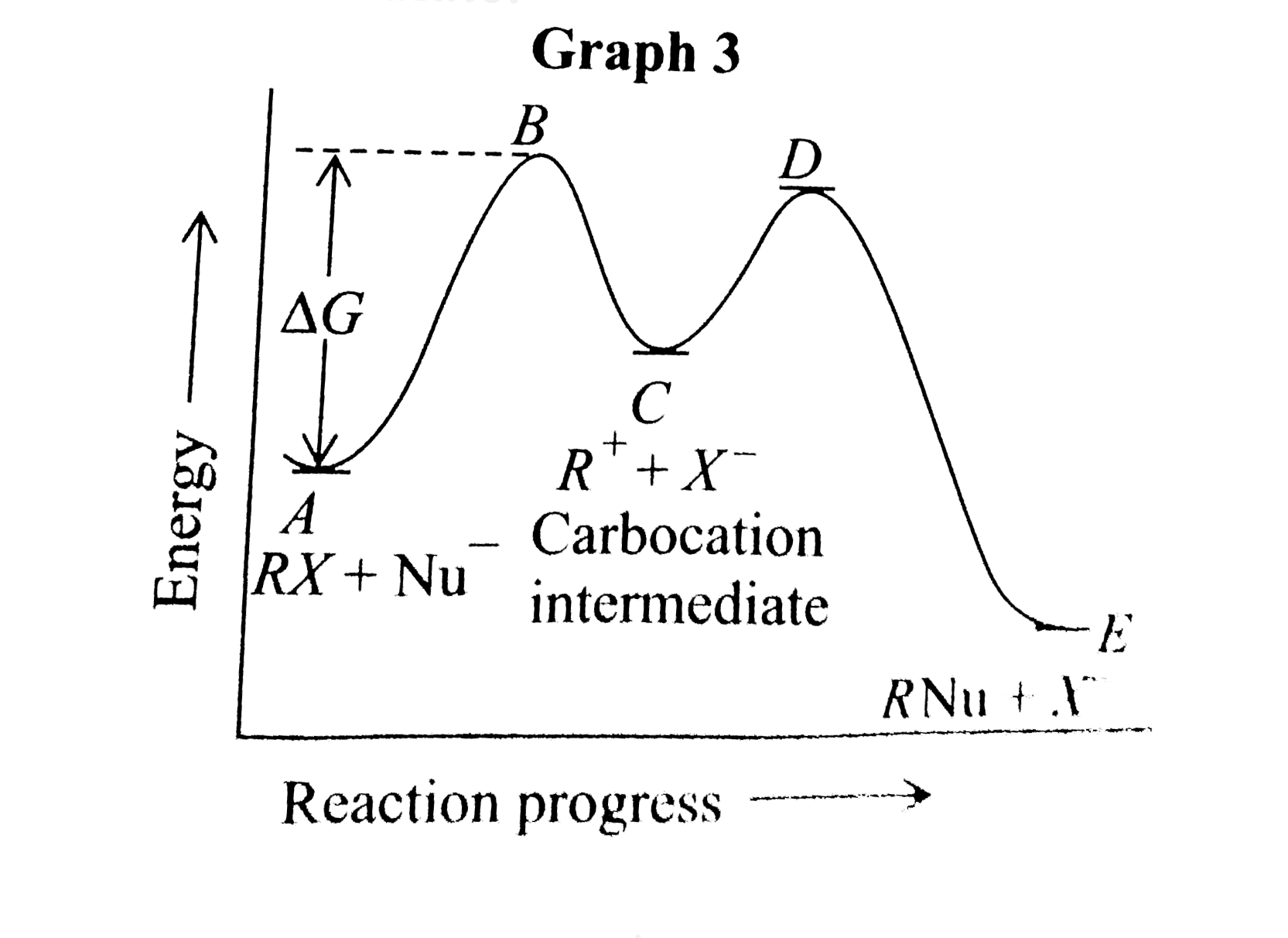
In the graph 3 for SN1 reaction the rate limiting step is the spontaneous dissociation of alkyl halide and is given by View SolutionQuestion 20
SN1 reaction is a first order nucleophilic substitution e.g.
CH3−CH3∣C∣CH3−Br+H2O→CH3−CH3∣C∣CH3−OH+HBr
The concentration of nucleophile does not appear in the rate law expression.
Reaction rate k[RX]
In a mulptistep organic reaction , the rate-limiting step is the slowest step . Rate determining step is represented by the following energy level diagram:
A reaction energy level diagram for an SN1 reaction .The rate limiting step is spontaneous dissociation of an alkyl halide to give a carbocation intermediate:
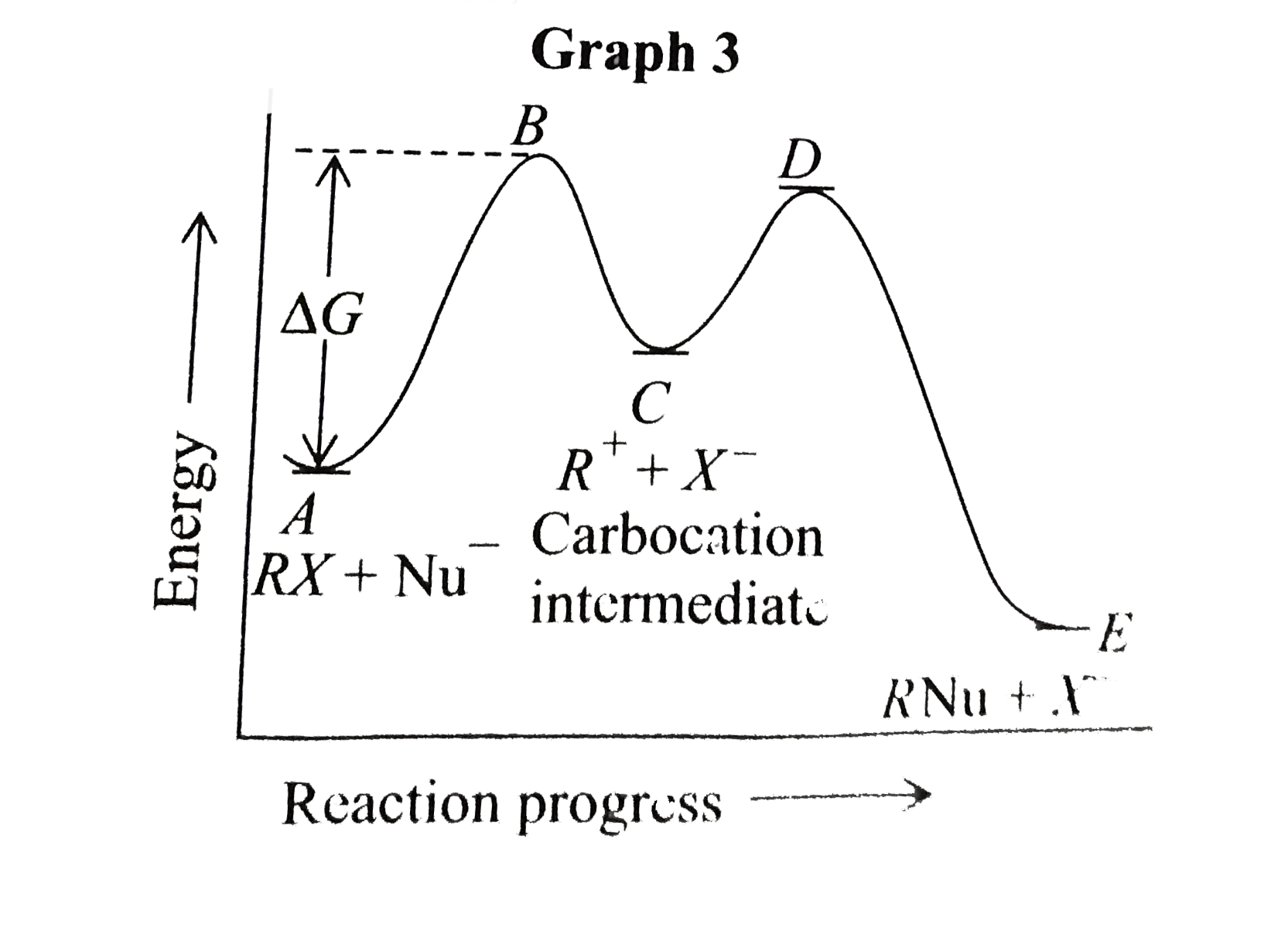
SN1 reaction is : View SolutionQuestion 21
Free radical halogenation takes place in the presence of light or at high temperature (abov 773K.) Formation of halogen free radical intermediate takes place in first step called chain initiation step.
CI2hv−−→2CI
This reaction is mainly given by those compound which have atleast one hydrogen atom present at sp3−hybrid carbon.
Reactivity of sp3−hybrid carbon depends on the reactivity of reaction intermediate.
The relative rate of formation of alkyl radicals by a chlorine radical is :
Tertiary(5)>Secondary(3.8)>Primary(1)
Percentage yield of the prodcut =Relative amount×100Sum of relative amounts
Relative amount = Number of hydrogen atoms on the respective carbon × relative reactivity.
NBS (N-bromo succinimide) is used for bromination at allylic and benzylic carbon, whereas Br2/hv gives bromination at benzylic allylic and alkyl carbon.
Select most reactive compound for chlorination in presence of light : View SolutionQuestion 22
Free radical halogenation takes place in the presence of light or at high temperature (abov 773K.) Formation of halogen free radical intermediate takes place in first step called chain initiation step.
CI2hv−−→2CI
This reaction is mainly given by those compound which have atleast one hydrogen atom present at sp3−hybrid carbon.
Reactivity of sp3−hybrid carbon depends on the reactivity of reaction intermediate.
The relative rate of formation of alkyl radicals by a chlorine radical is :
Tertiary(5)>Secondary(3.8)>Primary(1)
Percentage yield of the prodcut =Relative amount×100Sum of relative amounts
Relative amount = Number of hydrogen atoms on the respective carbon × relative reactivity.
NBS (N-bromo succinimide) is used for bromination at allylic and benzylic carbon, whereas Br2/hv gives bromination at benzylic allylic and alkyl carbon.
CH3CH2CH2CH3+CI2hv−−−−−→Light
CH3O∣CHCH2CH32-Chlorobutane+CH3CH2CH2CI1-Chlorobutane
Percentage yield of 2-chlorobutane will be: View SolutionQuestion 23
Free radical halogenation takes place in the presence of light or at high temperature (abov 773K.) Formation of halogen free radical intermediate takes place in first step called chain initiation step.
CI2hv−−→2CI
This reaction is mainly given by those compound which have atleast one hydrogen atom present at sp3−hybrid carbon.
Reactivity of sp3−hybrid carbon depends on the reactivity of reaction intermediate.
The relative rate of formation of alkyl radicals by a chlorine radical is :
Tertiary(5)>Secondary(3.8)>Primary(1)
Percentage yield of the prodcut =Relative amount×100Sum of relative amounts
Relative amount = Number of hydrogen atoms on the respective carbon × relative reactivity.
NBS (N-bromo succinimide) is used for bromination at allylic and benzylic carbon, whereas Br2/hv gives bromination at benzylic allylic and alkyl carbon.
which one of the following compounds will react with NBS?View SolutionQuestion 24
Free radical halogenation takes place in the presence of light or at high temperature (abov 773K.) Formation of halogen free radical intermediate takes place in first step called chain initiation step.
CI2hv−−→2CI
This reaction is mainly given by those compound which have atleast one hydrogen atom present at sp3−hybrid carbon.
Reactivity of sp3−hybrid carbon depends on the reactivity of reaction intermediate.
The relative rate of formation of alkyl radicals by a chlorine radical is :
Tertiary(5)>Secondary(3.8)>Primary(1)
Percentage yield of the prodcut =Relative amount×100Sum of relative amounts
Relative amount = Number of hydrogen atoms on the respective carbon × relative reactivity.
NBS (N-bromo succinimide) is used for bromination at allylic and benzylic carbon, whereas Br2/hv gives bromination at benzylic allylic and alkyl carbon.
Arrange decreasing order of reactivity of given compounds with NBS :(N-bromo succinimide)
I.C6H5−CH3
II.C6H5−CH2−CH2CH3
III.C6H5−CH2−CH=CH2
IV.C6H5−CH∣CH3−CH=CH2
Select the correct answer from the codes given below
Codes: View SolutionQuestion 25
Free radical halogenation takes place in the presence of light or at high temperature (abov 773K.) Formation of halogen free radical intermediate takes place in first step called chain initiation step.
CI2hv−−→2CI
This reaction is mainly given by those compound which have atleast one hydrogen atom present at sp3−hybrid carbon.
Reactivity of sp3−hybrid carbon depends on the reactivity of reaction intermediate.
The relative rate of formation of alkyl radicals by a chlorine radical is :
Tertiary(5)>Secondary(3.8)>Primary(1)
Percentage yield of the prodcut =Relative amount×100Sum of relative amounts
Relative amount = Number of hydrogen atoms on the respective carbon × relative reactivity.
NBS (N-bromo succinimide) is used for bromination at allylic and benzylic carbon, whereas Br2/hv gives bromination at benzylic allylic and alkyl carbon.
Chlorinating agent for free radical chlorination may be taken as : View SolutionQuestion 26
For a typical nucleophilic aromatic substitution reaction to take place .
1. Nucleophilic atom should be of oxygen nitrogen or sulphur.
2. Leaving groups should be halide.
3. There should be strong electron withdrawing at ortho and para position to leaving group.
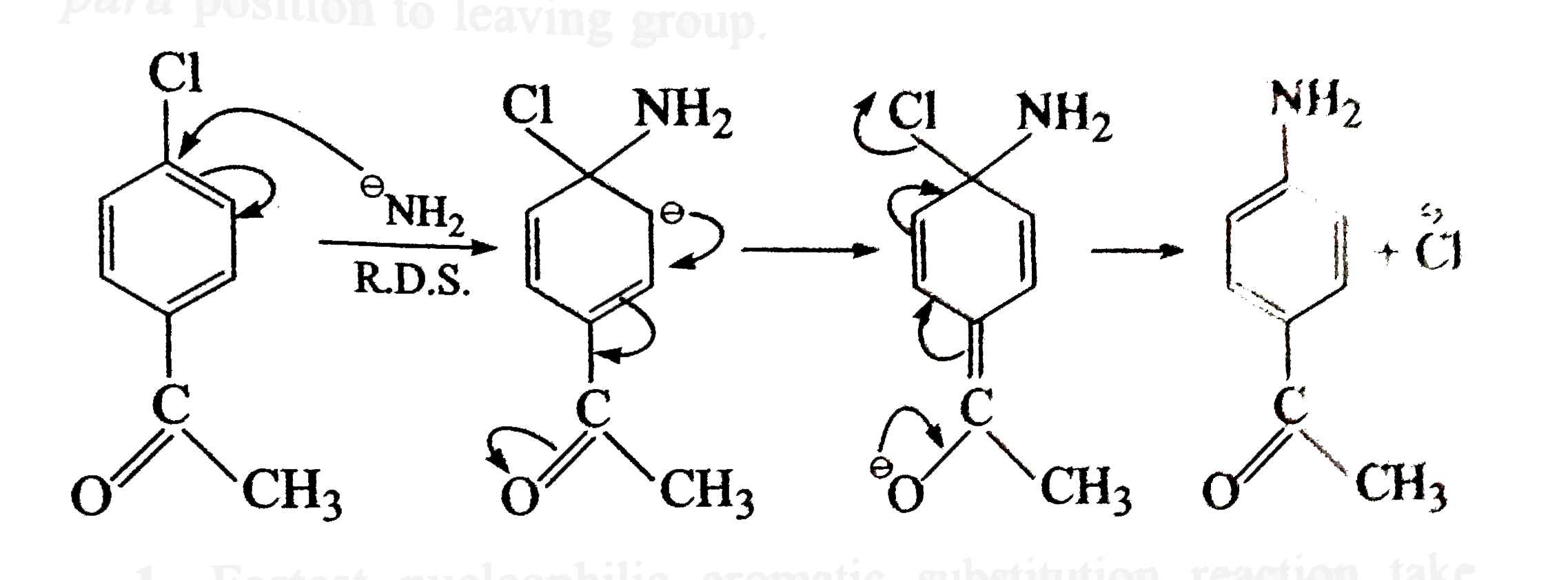
Fastest nucleophilic aromatic substitution reaction take place in : View SolutionQuestion 27
For a typical nucleophilic aromatic substitution reaction to take place .
1. Nucleophilic atom should be of oxygen nitrogen or sulphur.
2. Leaving groups should be halide.
3. There should be strong electron withdrawing at ortho and para position to leaving group.
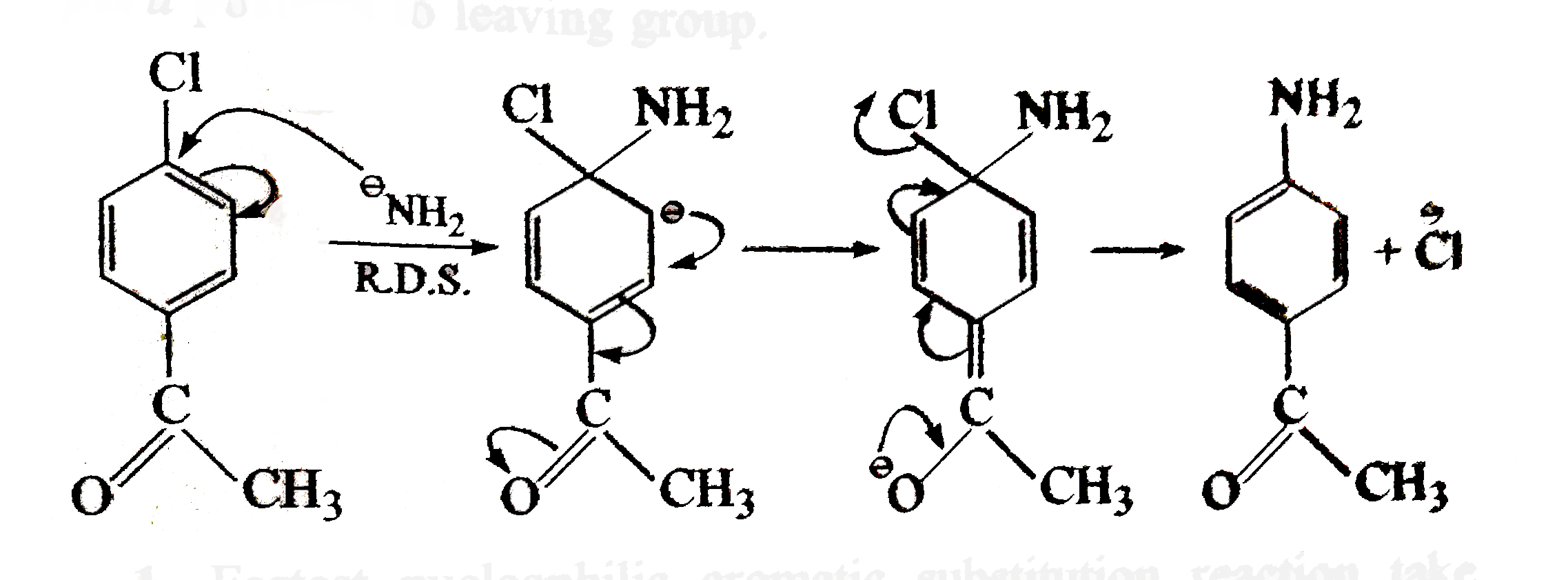
Find out correct product of following reaction
 View Solution
View SolutionQuestion 28
For a typical nucleophilic aromatic substitution reaction to take place .
1. Nucleophilic atom should be of oxygen nitrogen or sulphur.
2. Leaving groups should be halide.
3. There should be strong electron withdrawing at ortho and para position to leaving group.
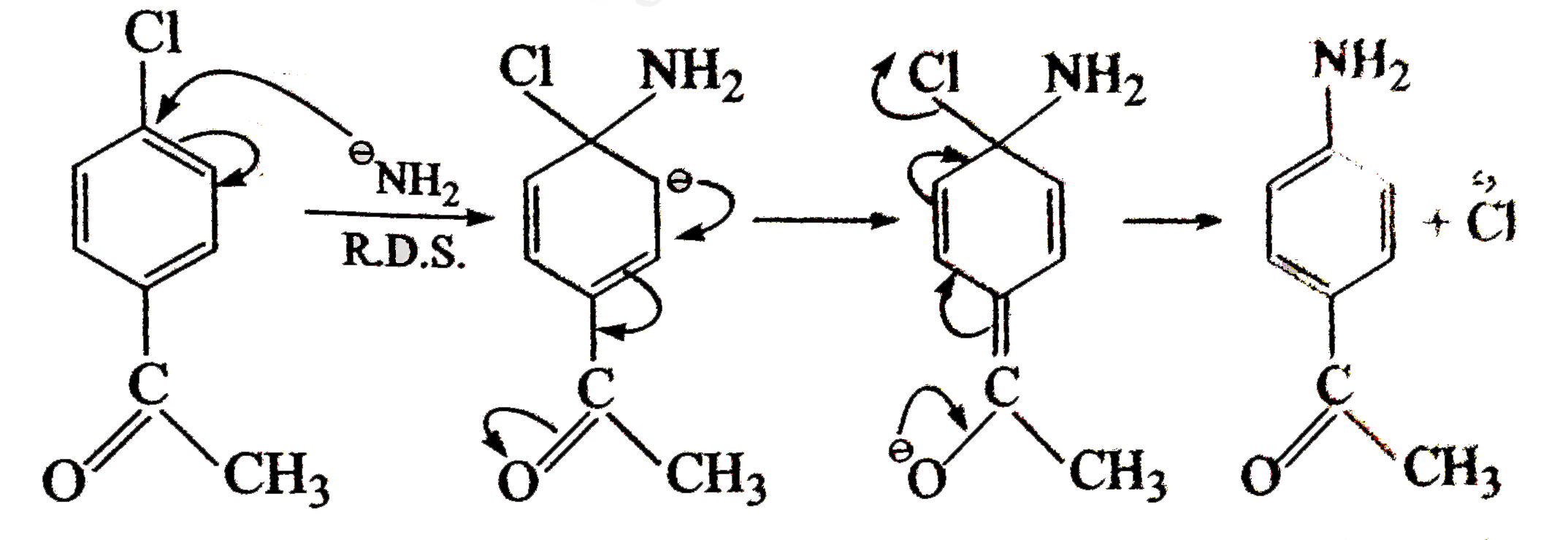
Compare rate of nucleophilic aromatic substitution reaction in following reactants:
 View Solution
View Solution
All Exercises from G.R. BATHLA & SONS CHEMISTRY Class 12 CHEMISTRY HALOALKANES AND HALOARENES
- Assertion -Reason Type Questions
- Example
- Linked comprehension type questions passage
- Matching type
- Matrix -Match Type Questions
- Objective Questions
- Objective Questions Lavel -B
- Objective Questions Lavel -B Set II This set contains the questions
- Problem
- Problem For Practice
- Problems based on structure and properties
- Single Interger answer type questions
- illustrations of objective questions